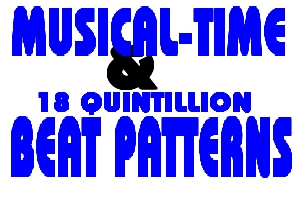|
Bill Powelson's,
MUSICAL TIME & RHYTHMS:

"FINITE TO INFINITY"
Snare/Bass Quad Chart

CODE:
- Snare = S
- Bass = B
- Snare or Bass = S/B
- Inversion = INV
- Cymbal = C
Note: When writing rhythms, stick with the coding. Do not place "B" type patterns on the snare line or "S" type patterns on the bass line. This will reverse the downbeat/upbeat flow of the music. Inversions (Inv.) Can be utilized but they often confuse the flow. "B/S" type patterns may be used on either line.
 Using the Chart to Create
Half Measure Rock Beats
Now let's use the above chart to create a familiar beat. You will be playing four repetitious notes on the cymbal. Next, choose pattern#3 for the snare line and pattern#1 for the bass line. Do you recognize this beat? It is basic rock with a new name. By the chart we would call it S3/B1.
Constructing S3/B1 (basic rock)

Are you beginning to see how the chart can help you to discover Billions of new rhythms? Grab some scratch paper then write and play a few patterns of your own. Eighth 2/4 contains a total of 256 possible variations.
HINTS: Some of these beats can be very difficult to play.
- 1. Play all sixteen bass patterns against S3 on the snare as an early project.
- 2. Then play all sixteen as snare figures against S1 on the bass.
- 3. Avoid a mixture like S12/B13, they are guaranteed to drive you insane.
Awareness should be your main goal. There is not enough time remaining in your life to play every beat that we are about to discover. If you understand how the chart works then you are probably ready to move on.
Let's investigate some possibilities with 8th "rock" 4/4.
Notice: I often omit 'rests' from the music notation samples as they have a tendency to confuse the newer students. I'm trying to keep everything as simple as possible.

locate these numbers on the chart. On the snare line you see numbers 3 and 10 while on the bass we have numbers 1 and 5. The whole concept should have hit you like a ton of bricks by now. If it hasn't then go back and study it again.
In eighth 'rock' 4/4 you will discover 65,536, single measure beat possibilities and nearly 4.3 billion, two measure patterns. Also, no rule says you must stop with two measure variations though most commercial music seems to be limited to that.
PERMUTATION CALCULATOR:
Now it's time to click on the PERMUTATION CALCULATOR , and play around with it
a little. Enter a number between 1 and 32 at the prompt. The Calculator
will then compute the number of permutations within that specific beat framework,
then tell you some of the potential time-signature formulas that might be used to
write those permutations. At the bottom of the calculator, there's an area where you
can enter and examine your own beats. Of course, the beats you may design could also
be entered into the drum machine and heard as well.
Look for drummer.exe file (drum machine) in the download version of this ebook.
Food for thought:
With permutations in mind you should now return to the
Primary Dance Beats
lesson, scan over the various beats and think, think, think. You will be
flooded with awareness. This same general permutation theory will apply to
any form of any time signature, including all the primary 3/4 and 4/4 dance beats. The Blues beat
will use a chart based on three or a 'Tri' chart. The shuffle beat is based on
the same 'Tri' chart as well, and then there is the Waltz beat. Study it next.
NEXT LESSON:

Copyright Bill Powelson
1985-2xxx all rights
reserved.
|